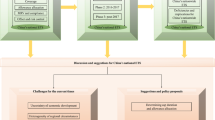Abstract
Numerous policy options exist to reduce future greenhouse gas emissions. A single-basket approach, which controls aggregate emissions, was adopted by the Kyoto Protocol. Such an approach allows emissions reductions of one gas to be traded with those of other gases in the “basket”, with the trade “price” determined by some weighting metric like the Global Warming Potential. To reduce stratospheric ozone depletion, the Montreal Protocol also dealt with controlling many compounds, but did so employing an alternative, multi-basket scheme. Trading was allowed within each basket, but not among baskets. While the Montreal Protocol has been highly successful using this approach, we show that if a single-basket approach had been adopted the short-term success could have been at risk due to the non-unique relationship between controls and environmental impacts when using a single basket. Using climate policy as an example, and without considering technological and economic constraints, we further show that the magnitude of the ambiguities in impacts associated with a single-basket approach depends on the rapidity of the emission phaseout. Fast phaseouts lead to less ambiguity than do slow ones. These results suggest that for each set of greenhouse gas control policies considered, the benefit of additional flexibility associated with a single-basket approach should be weighed against the associated increased uncertainties in the impacts to ascertain whether a single- or a multi-basket approach has the greater chance of successfully mitigating climate change.


Similar content being viewed by others
Notes
In this work, we use the term “trading” to represent the substitution of one gas for another that is in the same basket, with the magnitude of the substitution allowed defined by the ODP or GWP. Our use of “trading” does not refer to any trading among the nations participating in either of the protocols.
The Montreal Protocol defines consumption as equal to production plus imports minus exports. Globally, the two are equal. Because our calculations are globally based, we will use the term “consumption” throughout the rest of the text when we refer to production or consumption in relation to Montreal Protocol controls.
The definitions of all groups of ozone-depleting substances and the phaseout schedules are found in the Amended and Adjusted Montreal Protocol on Substances that Deplete the Ozone Layer (http://ozone.unep.org).
The compounds in the Kyoto single basket include CO2, CH4, N2O, hydrofluorocarbons (HFCs), perfluorocarbons (PFCs), and SF6. The magnitudes of the emission reductions for the first commitment period can be found in the text of the Kyoto Protocol to the United Nations Framework Convention on Climate Change (http://unfccc.int/essential_background/kyoto_protocol/background/items/1351.php)
References
Daniel JS, Solomon S, Albritton DL (1995) On the evaluation of halocarbon radiative forcing and global warming potentials. J Geophys Res 100(D1):1271–1285
Daniel JS, Fleming EL, Portmann RW, Velders GJM, Jackman CH, Ravishankara AR (2010) Options to accelerate ozone recovery: ozone and climate benefits. Atmos Chem Phys 10(16):7697–7707
Fuglestvedt JS, Berntsen TK, Godal O, Skodvin T (2000) Climate implications of GWP-based reductions in greenhouse gas emissions. Geophys Res Lett 27(3):409–412
Fuglestvedt JS, Berntsen TK, Godal O, Sausen R, Shine KP, Skodvin T (2003) Metrics of climate change: assessing radiative forcing and emission indices. Clim Change 58(3):267–331
Harvey LD (2000) Global warming: the hard science. Pearson Education Limited, Essex
IPCC (1990) Climate change: the IPCC scientific assessment. Cambridge University Press, Cambridge
IPCC (2009) Meeting report of the expert meeting on the science of alternative metrics. IPCC Working Group I Technical Support Unit, University of Bern, Bern, Switzerland.
Jackson SC (2009) Parallel pursuit of near-term and long-term climate mitigation. Science 326:526–527
Lashof DA, Ahuja DR (1990) Relative contributions of greenhouse gas emissions to global warming. Nature 344:529–531
Manne AS, Richels RG (2001) An alternative approach to establishing trade-offs among greenhouse gases. Nature 410(6829):675–677
Newman PA, Oman LD, Douglass AR, Fleming EL, Frith SM, Hurwitz MM, Kawa SR, Jackman CH, Krotkov NA, Nash ER, Nielsen JE, Pawson S, Stolarski RS, Velders GJM (2009) What would have happened to the ozone layer if chlorofluorocarbons (CFCs) had not been regulated. Atmos Chem Phys 9:2113–2128
O’Neill BC (2000) The jury is still out on global warming potentials. Clim Change 44(4):427–443
Riahi K, Gruebler A, Nakicenovic N (2007) Scenarios of long-term socio-economic and environmental development under climate stabilization. Technol Forecast Soc Change 74(7):887–935
Shine KP (2009) The global warming potential-the need for an interdisciplinary retrial. Clim Change 96(4):467–472. doi:10.1007/s10584-009-9647-6
Smith SJ, Wigley TML (2000) Global warming potentials: 2. Accuracy. Clim Change 44(4):459–469
Smith SJ, Wigley TML (2006) Multi-gas forcing stabilization with Minicam. Energ J:373–391.
Solomon S, Albritton DL (1992) Time-dependent ozone depletion potentials for short- and long-term forecasts. Nature 357:33–37
Solomon S, Mills M, Heidt LE, Pollock WH, Tuck AF (1992) On the evaluation of ozone depletion potentials. J Geophys Res 97(D1):825–842
van Vuuren DP, Den Elzen MGJ, Lucas PL, Eickhout B, Strengers BJ, van Ruijven B, Wonink S, van Houdt R (2007) Stabilizing greenhouse gas concentrations at low levels: an assessment of reduction strategies and costs. Clim Change 81(2):119–159. doi:10.1007/s10584-006-9172-9
Wigley TML (1998) The Kyoto Protocol: CO2, CH4 and climate implications. Geophys Res Lett 25(13):2285–2288
WMO (2007) Scientific assessment of ozone depletion: 2006. Global ozone research and monitoring project, report #50, Geneva, Switzerland.
Wuebbles DJ (1983) Chlorocarbon emission scenarios: potential impact on stratospheric ozone. J Geophys Res 88(C2):1433–1443
Acknowledgements
We thank G.-K. Plattner for providing the Bern carbon cycle model to us and for participating in many helpful discussions regarding its use. JSD and SS acknowledge funding from the National Oceanic and Atmospheric Administration’s Atmospheric Composition and Climate Program. JSF’s contribution was funded by the Norwegian Research Council within the project “Climate and health impacts of Short-Lived Atmospheric Components (SLAC)”.
Author information
Authors and Affiliations
Corresponding author
Electronic Supplementary Material
Below is the link to the electronic supplementary material.
Supplementary Information
(DOC 55 kb)
Rights and permissions
About this article
Cite this article
Daniel, J.S., Solomon, S., Sanford, T.J. et al. Limitations of single-basket trading: lessons from the Montreal Protocol for climate policy. Climatic Change 111, 241–248 (2012). https://doi.org/10.1007/s10584-011-0136-3
Received:
Accepted:
Published:
Issue Date:
DOI: https://doi.org/10.1007/s10584-011-0136-3




